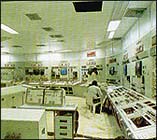| HOME | NEWS | SPECIALS | ||||


|
||||||||
|
Part 1
'A failure on all fronts!'George Iype Two weeks before Russian President Vladimir Putin arrived in India, senior officials led by Nuclear Power Corporation of India Limited Chairman and Managing Director V K Chaturvedi visited Moscow.
When they returned to their offices at Anushakti Nagar, Bombay, they were excited. They had waited 12 years for the Kudankulam project to materialise. It was in 1988 that Prime Minister Rajiv Gandhi had signed the energy pact with Soviet leader Mikhail Gorbachev. Putin's visit was a cause of celebration at NPCIL and the Bhabha Atomic Research Centre. After years of official apathy and indifference to a programme that was conceived as the torchbearer to India's energy needs, it was finally moving forward. Despite five decades of research and development, planning and execution, India's record in producing electricity from nuclear plants remains abysmally poor. Today, India is in the select league of nuclear nations. But the electricity it produces from nuclear reactors is less than 3 per cent of the installed capacity. Contrast this with the production levels in other nations. In France, nuclear plants produce 75 per cent of the country's electricity. In the United States, it is 19.8 per cent, the United Kingdom 28.87 per cent, and Russia 14.41 per cent.
The installed capacity of nuclear power in the country today is just 2,280 MW. Or, to put it in perspective, just 2.65 per cent of the total electricity produced in India. After a couple more projects are completed, the capacity is expected to touch 3,000 MW. INDIA'S nuclear energy production cost is the highest in the world. The Indian Atomic Energy Commission was set up in August 1948, to use nuclear energy for peaceful purposes. But when the government felt the nuclear programme was going nowhere, it set up NPCIL in 1987. According to NPCIL's balance sheets (1994-95 to 1998-99), the corporation has spent Rs 92.43 billion. If we take this as the total cost for producing 2,280 MW of energy, we have spent Rs 450 million for one MW of nuclear energy in the last five years. The DAE and the NPCIL have now redrafted India' s nuclear energy target. According to their Vision 2020 document, India will have an installed nuclear capacity of 20,000 MW by 2020. But there has never been any dearth of such papers. Experts say it is not lack of vision or expertise, but skewed government policies that have let down the country's nuclear energy programme. "The programme certainly should not be left to be run the way it is run at present by the Department of Atomic Energy," says Dr A Gopalakrishnan. Dr Gopalakrishnan should know. He headed the Atomic Energy Regulatory Board from 1993 to 1996. According to him, if India's nuclear power programme remains choked, it is because we have not divided our nuclear activities into civilian and military components. "Now that India has declared itself a nuclear-weapon power, it is high time we separated our nuclear activities clearly into civilian and military components. Let the civilian work on nuclear power plants be scrutinised and funded like any other power project in terms of investments and returns on investment and, more importantly, on the basis of per kilowatt-hour price for nuclear electricity and what it means to public safety," he says. Officials put forward various reasons for the malady that has affected the energy programme. Some say that even though the government supported the cause of nuclear power, there has been an acute lack of long-term plans. "There has been not much budgetary support for the programme. Whatever the government allocated us was just enough to meet the salaries of employees and the maintenance of offices," says a senior NPCIL official. The budgetary allocation for the nuclear power programme continued at Rs 3 billion annually till 1999. But last year, the government allocated nearly Rs 9.5 billion to the NPCIL. The change of heart, officials say, was mainly because the Bharatiya Janata Party government was bolstered by the Pokhran nuclear blasts in 1998. EXPERTS cite two compelling reasons for the stagnation of the energy programme. First, the Pokhran nuclear tests in 1974 and 1988. Second, the hackneyed Indian Atomic Energy Act. According to NPCIL MD V K Chaturvedi, after the Pokhran tests in 1974, the energy programme suffered because India was isolated. "The tests stopped the technical aids for setting up nuclear power plants and purchases of reactors. We were forced to prepare everything on our own. It significantly delayed our projects," he says. Officials say the 1974 tests affected the energy programme even more. International sanctions against India at a time when the country was on the threshold of completing some major projects held it up badly. "Financial institutions like the International Monetary Fund and the World Bank did not give us aid. So our projects went into the doldrums," Chaturvedi points out. But what throttled the programme most was the Indian Atomic Energy Act of 1962 (Click for an external link). It prohibits private and public equity from within and outside the country. The act prescribes that the nuclear programme should be shrouded in secrecy. It provides the DAE enormous powers and the right to withhold any information. The programme, it says, should be run by the DAE with limited participation from private industries. Thus, the role of industries is limited to that of just vendors, not participants. Critics call the DAE an 'unaccountable organisation'. "It is neither accountable to Parliament nor to the government," says an official. "It is only in India that the nuclear power programme is being implemented as a departmental programme by the DAE. Nuclear energy projects should be a national programme like in other countries," he adds. In the United States, France and Britain, private industries serve as partners in nuclear power generation. "Our Atomic Energy Act needs to be changed because it does not allow us to attract private industries. Instead of facilitating, the act has stunted the growth of nuclear power projects in the country," Chaturvedi says. Lack of political will added to the problems hindering energy generation. Particularly, officials point out, the Congress government under P V Narasimha Rao from 1991 to 1996 showed no interest in the projects. "The Rao government stopped all funding for energy projects. We could set up no plants during this phase," says the NPCIL chairman. "It was total stagnation."
"Our nuclear energy programme has been a failure on all fronts. We have wasted millions of rupees on a project that is yet to give us any satisfactory results," says Dr A S Cheema, a Madras-based expert. There are many like him who say the programme can succeed only if it is planned and controlled more tightly, under careful parliamentary and financial scrutiny and adhering to international safety norms. "Our nuclear power programme lacks transparency," Dr Cheema adds. What worries experts is not the fact that an ambitious programme has become a white elephant, but the reality that some plants are disasters-in-the-make.
ON TO PART 2
Return to Darkness at noon
Page design: Dominic Xavier
|
|||||||
 Their mission was to finalise the multimillion-rupee pact with Russia for setting up India's largest nuclear power plant at Kudankulam in Tamil Nadu.
Their mission was to finalise the multimillion-rupee pact with Russia for setting up India's largest nuclear power plant at Kudankulam in Tamil Nadu.
 In 1944 Homi Jehangir Bhabha, prime architect of India's atomic energy programme, had predicted that we could become a powerhouse of nuclear energy. But successive governments lacked the vision and enthusiasm to achieve his dream.
In 1944 Homi Jehangir Bhabha, prime architect of India's atomic energy programme, had predicted that we could become a powerhouse of nuclear energy. But successive governments lacked the vision and enthusiasm to achieve his dream.
 This led to a disastrous result: migration of qualified manpower from nuclear industries to other sectors. In the last two decades, many brilliant scientists and researchers from NPCIL and BARC have joined the private sector.
This led to a disastrous result: migration of qualified manpower from nuclear industries to other sectors. In the last two decades, many brilliant scientists and researchers from NPCIL and BARC have joined the private sector.
